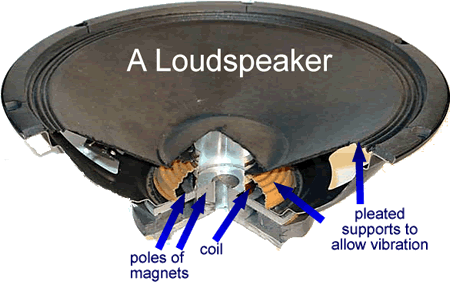 The Loudspeaker
The Loudspeaker


An alternating electrical current passes through the coil. This has the same frequency variation as the sound it wants the speaker to emit.
When a current passes through the coil it has a magnetic field around it. It is fixed to the paper cone and the bottom of the coil acts like a pole of a magnet. If the polarity of the electromagnet pole is the same as that on the fixed magnet (in this illustration a south pole) the coil will be repelled from the magnet and move upwards - taking the cone with it. When the signal reverses the opposite is true and it it pulled down towards the magnet.
The alternating signal therefore makes the cone move up and down.
The up and down movement sets up a sound wave of the same frequency as the electrical signal and the loudspeaker makes a sound.
The higher the current in the coil the stronger the magnetic field around it and therefore the bigger the force of attraction/repulsion between the electromagnetic coil and the fixed magnet. This results in increased amplitude of vibration and the sound produced will be louder.
This is an example of the use of the Motor Effect.
Java Link
